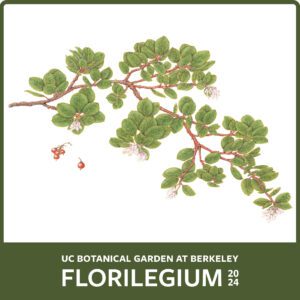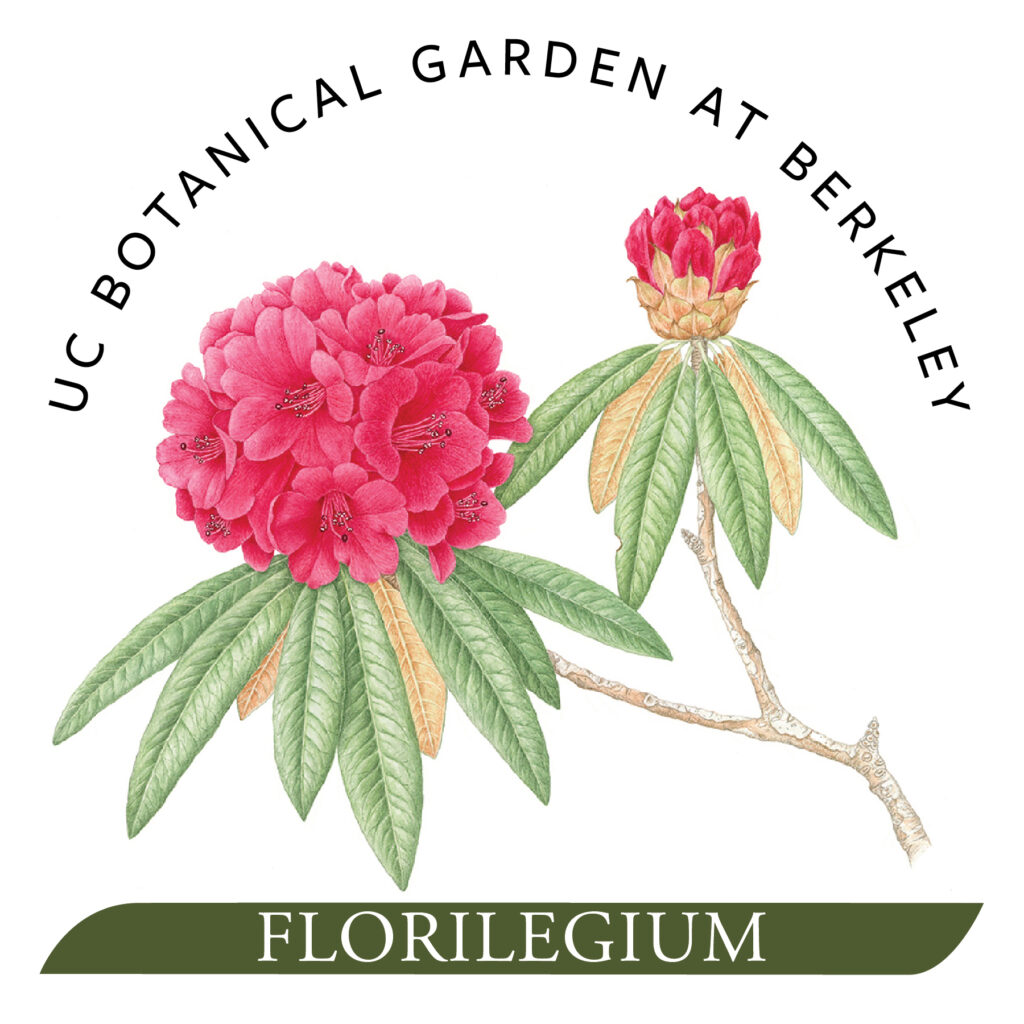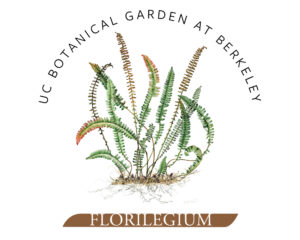
UCBG Florilegium
Centuries before digital or analog photography was commonplace, botanists relied on detailed botanical illustrations to identify plants and flowers.
While many botanical illustrations are stunning works in their own right, they are more than just pretty pictures. A botanical illustration captures, and depicts, a plant’s life cycle; its form, color and descriptive details including flower, seed, stem and leaf structure. An artist may spend countless hours painstakingly measuring all aspects of the plant in order to create an accurate documentation of its unique features. The need for this artform continues, despite the availability of high-end photographic technology.
While contemporary botanical artists may utilize photographs as a resource, it’s no substitute for working with live plant material. And many artists travel to locations around the globe, working on site to record a plant in its natural habitat, with a focus on a specific geographical region, habitat, or plant species. Artists also utilize herbaria–dried, pressed, plant material–as a resource. Working with dried plant material requires a skillful interpretation, and imagination, to bring the plant “to life” via 3-dimensional renderings.
These visual plant records provide invaluable information for botanists, gardeners and conservationists, among others. In addition, there is a tradition of recording the florilegia contained in a garden. A florilegium is a collection of illustrations featuring plants growing in a specific area such as a botanical garden.
The UCBG Florilegium exhibitions continue this rich legacy and feature illustrations of plants in the collection by selected artists, who choose their subjects from a list of iconic plants. The works on view capture the plant information from root to leaf tip, and more. Viewers will enjoy the delicate beauty of each artwork, its subject painstakingly rendered; a testament to the artists’ technical skill and love of plants.
The project was conceived by renowned botanical illustrator and instructor, Catherine Watters, and developed with the support of staff and Advisory Board members Laura Sawczuk, Gina Baretta, and Katherine Greenberg. Advisory Board Member and former Director of Collections Chris Carmichael and Curator emeritus Holly Forbes developed the list of iconic plants from the collection for inclusion in the project.
There will be a series of five annual exhibitions, culminating in a publication of the UCBG Florilegium that will include all works in the collection.
We invite the public to explore The UCBG Florilegium—where art, history and science tangibly intersect. The exhibitions are hosted for two weeks in November and are free with Garden admission.
UCBG 2024 Florilegium Exhibition
November 1–November 21

Experience an immersive exhibition of 75 exquisite botanical illustrations featuring the unique flora of the UC Botanical Garden at Berkeley. This juried exhibition includes 31 new works shown alongside entries from our previous Florilegium exhibitions. The works on view display a mastery of technical skill, botanical accuracy and harmonious composition for a show of art that provides an engaging visual story of plants and their unique characteristics. Don’t miss this stunning exhibition of art!
Participating artists: Rubi Abrams, Alexandra Balestrieri, Cindy Barber, Gina Barretta, Beatrice Bergemont, Helen Byers, Cynthia Byrne-Margetts, Margi Connelly, Ruth Cox, Erika Hargesheimer, Joey Hansell, Susan Hill-McEntee, Elaine Jek, Leah Kaizer, Linda Kam, Peggy Kelly, Jenny Kennedy, Gwyn Lewis, Lee McCaffree, JoAnne Osberg, Judy Paris, Sally Petru, Cheryl Perko, Janice Ransley, Susan Mark Raymond, Jan Reddick, Laura Sawczuk, Lisa Sharafian, Catherine Watters
Image: Cynthia Byrne-Margetts – Presidio manzanita
UCBG 2023 Florilegium Exhibition
November 3–November 16, 2023
 Participating 2023 artists: Cindy Barber, Gina Barretta, Cynthia Byrne Margetts, Margi Connelly, Mary Ellen Grimes, Erika Hargesheimer, Susan Hill McEntee, Eliza Jewett, Leah Kaizer, Linda Kam, Heather Kostrzewa, Gwyn Lewis, Susan Mark-Raymond, Lee McCaffree, Joanne Osberg, Sally Petru, Jan Reddick, Barb Ward, Catherine Watters
Participating 2023 artists: Cindy Barber, Gina Barretta, Cynthia Byrne Margetts, Margi Connelly, Mary Ellen Grimes, Erika Hargesheimer, Susan Hill McEntee, Eliza Jewett, Leah Kaizer, Linda Kam, Heather Kostrzewa, Gwyn Lewis, Susan Mark-Raymond, Lee McCaffree, Joanne Osberg, Sally Petru, Jan Reddick, Barb Ward, Catherine Watters
Image: Catherine Watters – Rhododendron delavayi
UCBG 2022 Florilegium Exhibition
November 18–December 1, 2022

Participating 2022 artists: Rubi Abrams, Latifat Apatira, Cindy Barber, Gina Barretta, Mary Batchelder, Hyunjin Cho, Elaine Goldstone, Elizabeth Hansell, Erika Hargesheimer, Linda Kam, Deborah Kass, Heather Kostrzewa, Lynne Lyle, Lisa Martin, Lee McCaffree, Sally Petru, Vi Strain and Catherine Watters
Image: Latifat Apatira, Blechnum penna-marina